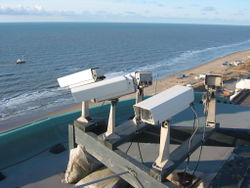Argus video monitoring system
Until only a few years ago, all information on nearshore morphodynamics had to be gathered from comprehensive field experience. This way of data collection has some fundamental limitations. One problem is the fact that such experiments are relatively expensive and that there is only a limited amount of instrument positions in traditional field experiments. A synoptical pattern is thus difficult to get with the use of a traditional field set up, but this can easily be measured with a shore-based video system. Another and even more important characteristic is the fact that the observation time scale is in practice limited to several weeks. Finally, surveying during severe weather and wave conditions is hardly possible. With the recent advent of new digital imaging technology, shore-based video systems now provide the additional capability of automated data collection, encompassing a much greater range of time and spatial scales than were previously possible.
The history behind video imaging in nearshore studies probably goes back to the 1930s, where the first attempts to study coastal processes were made with the help of aerial photography. In 1980, developments on video techniques for the monitoring of coastal changes have been initiated by the Coastal Imaging Lab of the Oregon State University, USA. Being continuously improved since 1992, the so-called Argus system (History of Argus) nowadays features fully digital video technology which provides high image quality in combination with detailed pixel resolution. Continuous (typically every daylight hour) collection of image data with a resolution of centimetres to meters, extending along regions of hundreds of meters to several kilometers, is now routinely undertaken at sites in the USA, Europe, Australia and Asia (Argus worldwide).
An Argus monitoring system typically consists of four to five video cameras, spanning a 180º view, and allowing full coverage of about four to six kilometers of beach. The cameras are mounted on a high location along the coast and connected to an ordinary PC on site, which in turn communicates to the outside world using conventional techniques such as an analog modems, ISDN, DSL, or a wireless LAN. Data sampling is usually hourly (although any schedule can be specified) and continues during rough weather conditions. As the process of data collection is fully automated, the marginal operating costs are virtually zero.
Each standard hourly collection usually consists of three types of images (Argus image types and conventions). A snapshot image serves as simple documentation of the ambient conditions but offers little quantitative information. Time exposure images average out natural modulations in wave breaking to reveal a smooth pattern of bright image intensities, which are an excellent proxy for the underlying, submerged sand bar topography. Time exposures also ‘remove’ moving objects from the camera field of view, such as ships, vehicles and people. Variance images help identify regions which are changing in time (like the sea surface), from those which may be bright, but are unchanging (like the dry beach).
Plan view, merged images (Argus standard image processing) can be composed by geo-referencing the images from all the cameras of an Argus station. This facilitates the measurement of length scales of morphological features like breaker bars and the detection of rip currents. Besides time-averaged video data, data sampling schemes can be designed to collect time series of pixel intensities, typically at 2 Hz, with which wave and flow characteristics can be investigated.
Other Argus pages on Coastal Wiki:
Please note that others may also have edited the contents of this article.
|
[[Category:Articles by {{{AuthorFullName}}}]]
